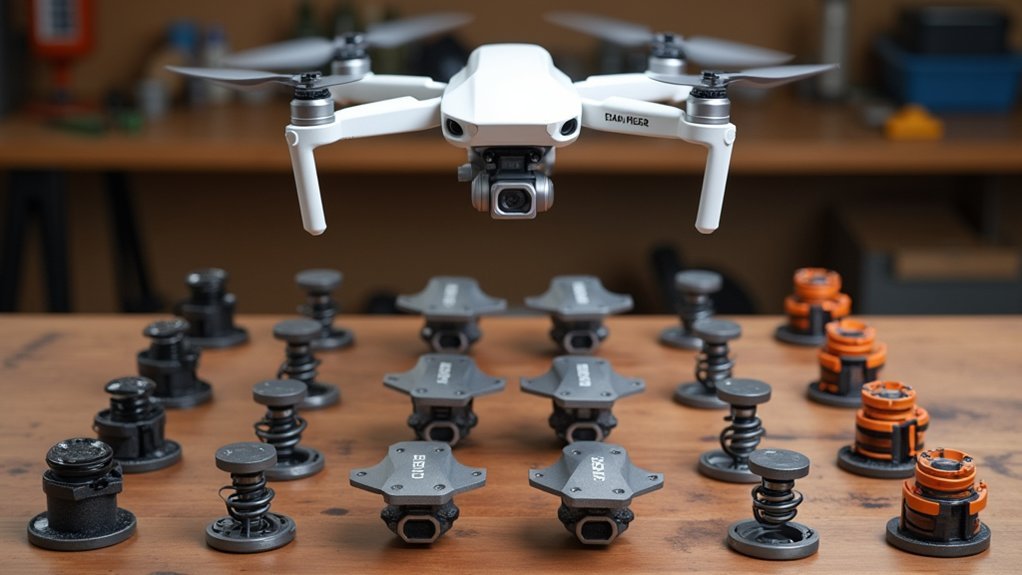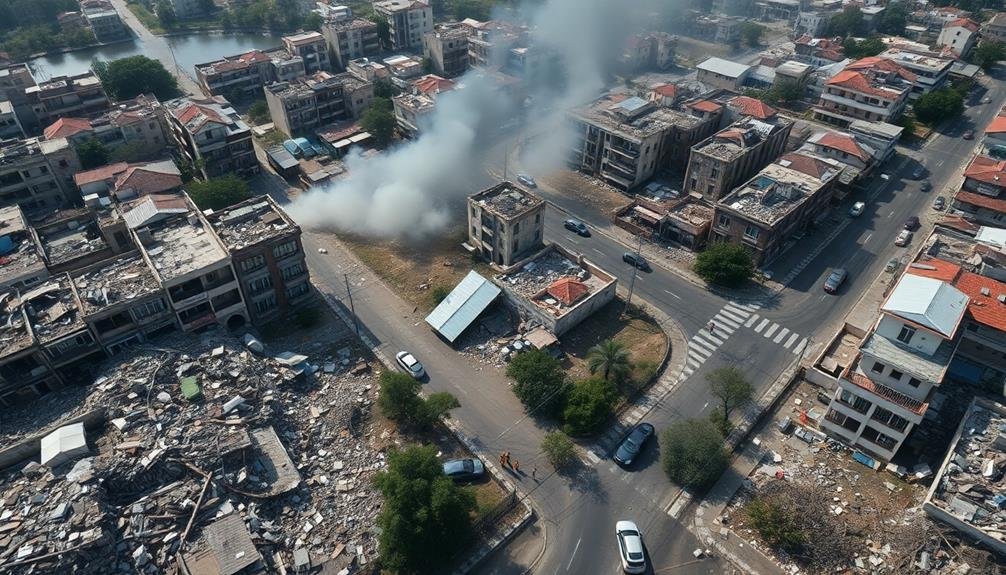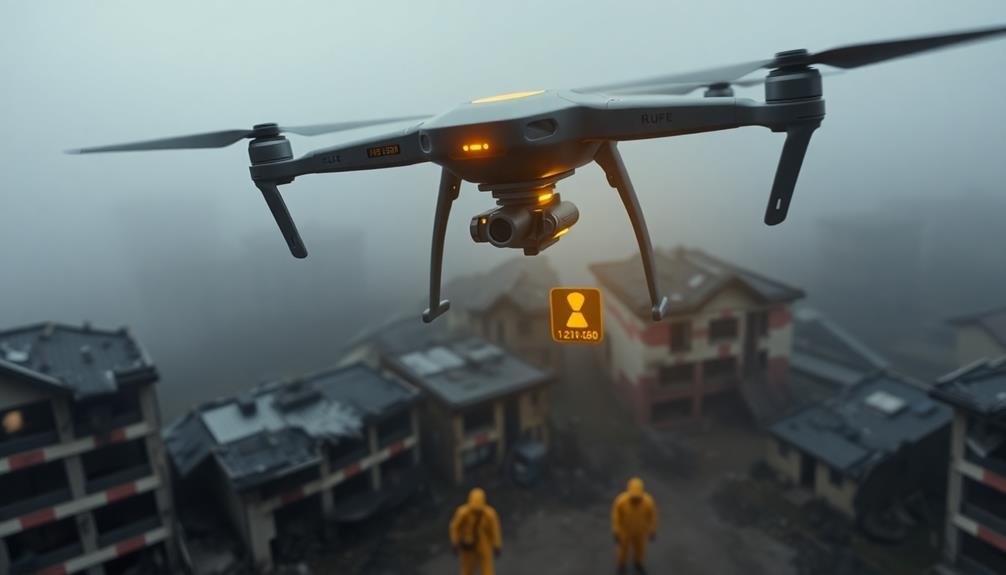To elevate your architectural visualization, you'll need high-quality gear. Start with a high-resolution camera drone for stunning aerial shots and wide-angle lenses to capture entire structures. Neutral density filters will help you balance exposures, while remote controllers with screens offer precise framing. Don't forget stabilizing gimbals for smooth footage and obstacle avoidance systems for safety. Propeller guards protect your drone in tight spaces, and portable power banks keep your gear running. Finally, invest in a quality drone landing pad for safe takeoffs and landings. There's much more to explore in the world of architectural photography equipment.
High-Resolution Camera Drones

Soaring above cityscapes, high-resolution camera drones have revolutionized architectural visualization. These flying cameras offer unique perspectives that were once impossible or prohibitively expensive to capture.
You'll find that drones equipped with 4K or even 8K cameras can deliver stunning aerial shots of buildings and their surroundings, providing context and scale that ground-level photography simply can't match.
When choosing a drone for architectural visualization, look for models with GPS stabilization and obstacle avoidance systems. These features guarantee smooth, steady footage and help prevent costly accidents.
Opt for drones with adjustable camera settings, allowing you to control aperture, shutter speed, and ISO for peak image quality in various lighting conditions.
Consider battery life and flight time when selecting your drone. Longer flight times give you more opportunities to capture the perfect shot. Additionally, invest in extra batteries and a multi-charger to extend your shooting sessions.
Don't forget about post-processing capabilities. Many high-end drones now offer RAW image capture, giving you greater flexibility in editing and color grading your footage. This feature is vital for achieving the polished look that architectural visualization demands.
Wide-Angle Lenses

Wide-angle lenses are essential for capturing entire structures in a single frame, allowing you to showcase the full scope of architectural designs.
You'll need to master distortion correction techniques to maintain straight lines and accurate proportions, especially when photographing tall buildings or interior spaces.
Consider the lens's low-light performance, as you'll often encounter challenging lighting conditions when shooting architectural subjects.
Capturing Entire Structures
Immense buildings and sprawling architectural marvels demand a lens that can capture their full grandeur. When you're tasked with photographing entire structures, wide-angle lenses become your best friend.
These lenses allow you to fit more of the scene into your frame, even when you're working in tight spaces or can't step back far enough to capture the whole building.
To make the most of wide-angle lenses for architectural visualization:
- Choose the right focal length: For full-frame cameras, lenses between 14mm and 24mm are ideal for capturing entire structures.
- Mind the distortion: Wide-angle lenses can cause perspective distortion, especially at the edges. Use this creatively or correct it in post-processing.
- Experiment with composition: Try different angles and viewpoints to showcase the building's unique features and proportions.
Distortion Correction Techniques
While wide-angle lenses are invaluable for capturing entire structures, they often introduce distortion that can detract from the accuracy of architectural visualization. To address this issue, you'll need to employ various distortion correction techniques.
One effective method is using tilt-shift lenses, which allow you to adjust the plane of focus and correct perspective distortion in-camera. Alternatively, you can use software solutions like Adobe Lightroom or DxO ViewPoint to correct lens distortion post-processing.
Here's a comparison of common distortion correction techniques:
| Technique | Pros | Cons | Best For | Difficulty |
|---|---|---|---|---|
| Tilt-Shift Lenses | In-camera correction | Expensive | Professional shoots | High |
| Software Correction | Affordable, flexible | Time-consuming | Post-processing | Medium |
| Perspective Control | Precise adjustments | Requires practice | Fine-tuning | Medium |
| Lens Profiles | Quick, automatic | Limited customization | Batch processing | Low |
| Manual Correction | Full control | Labor-intensive | Complex distortions | High |
When choosing a distortion correction method, consider your budget, time constraints, and the level of precision required for your architectural visualization project. Remember, mastering these techniques will greatly enhance the quality and accuracy of your architectural photographs.
Low-Light Performance Considerations
Frequently, architectural photographers find themselves working in challenging low-light conditions, especially when capturing interiors or nighttime exteriors.
When it comes to wide-angle lenses, low-light performance is vital for maintaining image quality and flexibility in these situations. You'll want to take into account lenses with larger maximum apertures, typically f/2.8 or wider, to allow more light to reach the sensor.
However, it's not just about the aperture. Here are three key factors to keep in mind for low-light performance in wide-angle lenses:
- Image stabilization: Look for lenses with built-in stabilization to reduce camera shake in low-light situations.
- Sensor performance: Pair your lens with a camera body that excels in high ISO settings to minimize noise.
- Lens coatings: Advanced coatings can reduce flare and ghosting, improving contrast in challenging lighting conditions.
Neutral Density Filters

For capturing stunning architectural images, neutral density (ND) filters are indispensable tools in your photography kit. These filters reduce the amount of light entering your camera's lens without affecting color balance, allowing you to use slower shutter speeds or wider apertures in bright conditions.
When photographing architecture, ND filters help you achieve several key effects. You can create long exposures to blur moving elements like clouds or people, emphasizing the stillness of buildings. They're also useful for balancing exposure in high-contrast scenes, such as interiors with bright windows.
ND filters come in various strengths, measured in stops of light reduction. You'll find fixed ND filters and variable ND filters, which offer adjustable density. For architectural work, consider a set of fixed ND filters (2, 4, and 6 stops) or a high-quality variable ND filter.
When using ND filters, remember to adjust your camera settings accordingly. You'll need to increase exposure time or open up your aperture to compensate for the reduced light.
A sturdy tripod is essential for the longer exposures you'll be using. With practice, ND filters will become a valuable asset in your architectural photography arsenal.
Remote Controllers With Screens

Remote controllers with screens offer you unprecedented control over your architectural shots.
You'll achieve precise framing and composition through live view advantages, allowing real-time adjustments without physically touching the camera.
These controllers also enable extended camera placement, letting you capture unique angles and perspectives that would be challenging to achieve otherwise.
Precise Framing and Composition
Architectural photographers often rely on remote controllers with built-in screens to achieve precise framing and composition. These devices allow you to see exactly what your camera sees, even when it's positioned in hard-to-reach places. You'll have full control over your shot's composition without physically touching the camera, reducing the risk of accidental movements or vibrations.
Remote controllers with screens offer several advantages for architectural photography:
- Real-time adjustments: You can fine-tune your composition, exposure, and focus directly from the controller.
- Improved ergonomics: It's easier to work for extended periods without straining your neck or back.
- Better client communication: Show your clients the live view and make instant adjustments based on their feedback.
When choosing a remote controller, look for one with a high-resolution screen that accurately represents colors and details.
Opt for models with intuitive interfaces and customizable controls to streamline your workflow. Some advanced controllers even offer features like focus peaking and histogram displays, further enhancing your ability to capture stunning architectural images.
Live View Advantages
Live view functionality on remote controllers with screens offers three key advantages for architectural photographers.
First, it provides real-time composition adjustments. You can see exactly what your camera sees without peering through the viewfinder, allowing you to fine-tune your framing and positioning with greater ease. This is especially useful when shooting from challenging angles or in tight spaces.
Second, live view enhances focus accuracy. You can zoom in on specific areas of the image to guarantee precise focus, which is vital for capturing sharp details in architectural elements. This feature is particularly valuable when using tilt-shift lenses or working with shallow depth of field.
Lastly, live view aids in exposure and lighting assessment. You'll see a real-time preview of your exposure settings, helping you make immediate adjustments to achieve the desired look. This is particularly beneficial when working with mixed lighting conditions or when balancing interior and exterior light in architectural shots.
Extended Camera Placement
Building on the advantages of live view, remote controllers with screens offer even more flexibility in camera placement. These devices allow you to position your camera in hard-to-reach or unconventional spots while maintaining full control over settings and composition. You'll be able to capture unique perspectives that would otherwise be impossible or dangerous to achieve.
Remote controllers with screens are particularly useful for architectural visualization as they enable you to:
- Place cameras at high vantage points, such as on cranes or scaffolding, to showcase a building's full scale and surroundings.
- Position cameras in tight spaces or corners to capture intricate architectural details.
- Set up multiple cameras simultaneously for time-lapse shots or synchronized multi-angle captures.
When selecting a remote controller, look for models with long-range connectivity, intuitive interfaces, and compatibility with your camera system. Some advanced controllers even offer features like focus peaking, histogram displays, and touchscreen functionality.
Stabilizing Gimbals

For capturing smooth, professional-looking footage in architectural visualization, stabilizing gimbals are indispensable tools. These devices help you eliminate camera shake and create fluid movements, enhancing the overall quality of your architectural videos and walkthroughs.
When choosing a gimbal, consider its weight capacity to guarantee it can support your camera setup. Three-axis gimbals offer the most stability, controlling pitch, roll, and yaw. Look for models with intuitive controls and long battery life for extended shooting sessions.
Some gimbals feature intelligent modes like time-lapse, panorama, and object tracking, which can add dynamic elements to your architectural presentations. You'll also want to check for compatibility with your specific camera model and any accessories you plan to use.
Practice using your gimbal before important shoots to master its operation. Balancing the camera properly is vital for peak performance.
Consider investing in additional accessories like extension poles or dual handles for more versatile shots.
Obstacle Avoidance Systems

When traversing complex architectural spaces, obstacle avoidance systems are essential for protecting your equipment and ensuring smooth footage. These intelligent systems use sensors to detect potential hazards and automatically adjust your camera's movement to avoid collisions.
They're particularly useful when working with drones or motorized sliders in tight spaces or unfamiliar environments.
Modern obstacle avoidance systems offer various features to enhance your architectural visualization workflow:
- Multi-directional sensing: Advanced systems can detect obstacles in all directions, allowing for safer and more versatile shooting angles.
- Adjustable sensitivity: You can fine-tune the system's responsiveness based on the complexity of the space you're working in.
- Integration with flight planning: Some systems work with pre-programmed flight paths, automatically adjusting routes to avoid obstacles while maintaining your desired composition.
When choosing an obstacle avoidance system, consider the specific needs of your architectural projects.
Look for systems that integrate seamlessly with your existing gear and offer real-time feedback.
Remember that while these systems provide an extra layer of protection, they're not foolproof. Always maintain visual contact with your equipment and be prepared to intervene manually if necessary.
Propeller Guards

Why are propeller guards essential for architectural photography drones? When you're capturing stunning images of buildings and structures, you'll often find yourself flying in tight spaces or near obstacles. Propeller guards act as a protective barrier, preventing damage to your drone and surrounding objects in case of accidental contact.
These guards wrap around your drone's propellers, shielding them from impacts. They're particularly useful when you're maneuvering around intricate architectural details or steering through narrow passages. You'll have greater confidence flying close to buildings, knowing that a slight miscalculation won't result in costly repairs or potential injuries.
Propeller guards also enhance safety for bystanders and property. They reduce the risk of injury if your drone comes too close to people or delicate surfaces. Additionally, they can help muffle propeller noise, making your drone less disruptive during shoots.
When choosing propeller guards, opt for lightweight materials like carbon fiber or durable plastics. Confirm they're compatible with your specific drone model and don't greatly impact flight performance.
While they may slightly reduce flight time due to added weight, the protection they offer far outweighs this minor drawback for architectural photography.
Portable Power Banks

With long days of shooting on location, portable power banks are indispensable for architectural photographers. These compact devices guarantee your camera, smartphone, and other essential gear stay powered throughout extended shoots.
When selecting a power bank, consider capacity, portability, and charging speed. Opt for high-capacity models offering at least 20,000mAh, which can recharge most DSLRs multiple times. Look for power banks with multiple ports, including USB-C for faster charging and compatibility with newer devices. Some advanced models even feature AC outlets, allowing you to power laptops or studio lights in a pinch.
To maximize your power bank's efficiency:
- Fully charge it before each shoot
- Use high-quality, short cables to minimize power loss
- Keep it protected from extreme temperatures, which can affect performance
Don't forget to pack the necessary cables and adapters for all your devices. Some photographers carry multiple power banks to guarantee uninterrupted shooting.
Drone Landing Pads

Launching and landing drones safely is essential for architectural photographers using aerial imagery. Drone landing pads provide a stable, visible surface for takeoffs and landings, protecting your equipment and ensuring smooth operations.
You'll want a portable, durable pad that's easy to set up and transport. Look for landing pads made from water-resistant materials like nylon or polyester. They should be lightweight yet sturdy enough to withstand wind and varying terrain.
Most pads fold up compactly, fitting easily into your gear bag. Choose a size that accommodates your drone model, typically ranging from 30 to 110 cm in diameter. High-contrast colors and reflective elements enhance visibility, vital for maintaining visual contact during flights.
Some pads feature weighted edges or stakes to prevent movement in windy conditions. Consider models with double-sided designs, offering options for different lighting situations. For night shoots, LED-equipped landing pads can be invaluable. They provide illumination for safe landings in low-light conditions.
Remember to check local regulations regarding drone use and always prioritize safety. A quality landing pad is an investment that protects your drone and enhances your architectural photography workflow.
Frequently Asked Questions
How Do Weather Conditions Affect Architectural Drone Photography?
Weather greatly impacts your architectural drone shots. You'll face challenges with wind, rain, and extreme temperatures. Sunlight and cloud cover affect lighting and shadows. You'll need to adapt your flight plans and camera settings accordingly.
What Software Is Best for Post-Processing Architectural Drone Images?
For post-processing architectural drone images, you'll find Adobe Lightroom and Photoshop essential. They're industry standards offering powerful tools for color correction, perspective adjustments, and detail enhancement. DxO PhotoLab and Capture One are also excellent alternatives you should consider.
Are There Specific Regulations for Drone Photography in Urban Areas?
You'll face specific regulations for urban drone photography. You're required to follow no-fly zones, altitude restrictions, and privacy laws. You'll need permits for commercial use and must adhere to local and federal aviation rules.
How Can I Capture Interior Spaces Effectively With Drone Photography?
You can't effectively capture interior spaces with drone photography. Drones are designed for outdoor use. Instead, use a wide-angle lens, tripod, and artificial lighting for interior shots. Consider a handheld gimbal for smooth movement indoors.
What Lighting Techniques Enhance Architectural Features in Drone Photography?
You'll want to use soft, diffused lighting to highlight architectural details. Try capturing during golden hour for warm tones. Experiment with backlighting to create dramatic silhouettes. Don't forget to adjust your drone's camera settings for ideal exposure.
In Summary
You've now got a thorough overview of essential gear for architectural visualization photography. By investing in high-quality drones, lenses, filters, and accessories, you'll be well-equipped to capture stunning images of buildings and structures. Don't forget to practice your flying skills and familiarize yourself with local drone regulations. With these tools at your disposal, you're ready to elevate your architectural photography to new heights. Get out there and start creating!

As educators and advocates for responsible drone use, we’re committed to sharing our knowledge and expertise with aspiring aerial photographers.




Leave a Reply